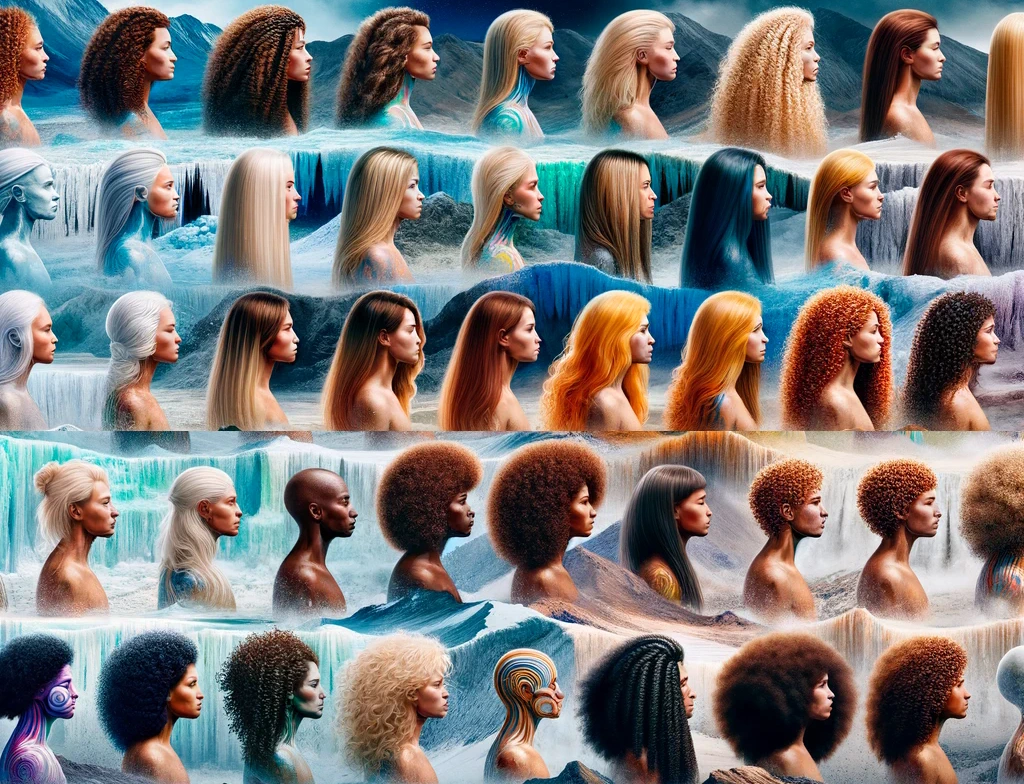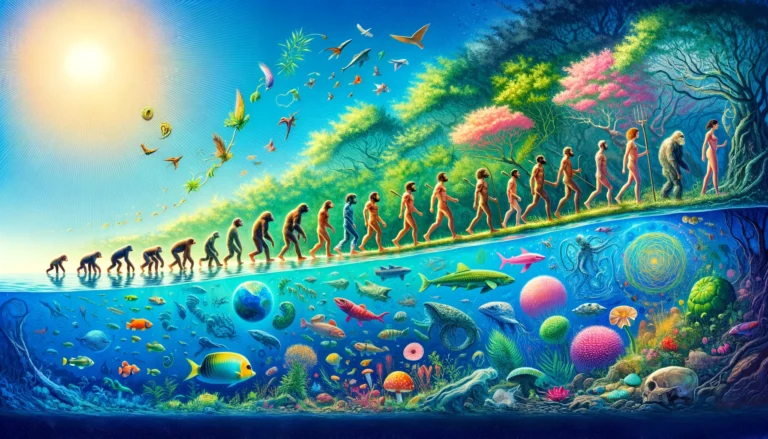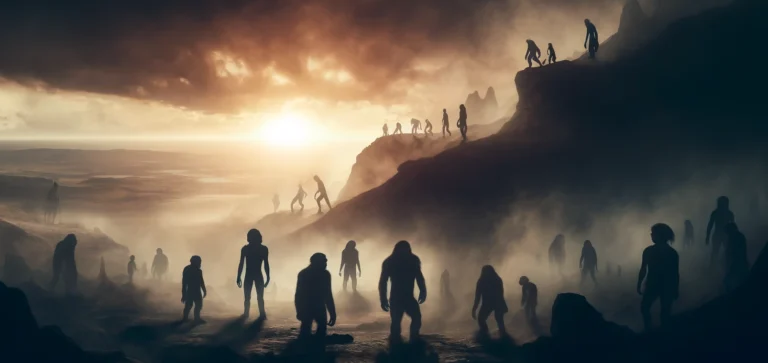The Ever-Changing Tree of Life: An Overview.
In 1859, the naturalist Charles Darwin revolutionized the scientific world with his seminal publication, “On the Origin of Species.” In it he formulated his scientific theory of evolution by natural selection. The process by which new species arise is well-understood, the evidence compelling and conclusive, our knowledge complete. We can read the fossil record like a book and on these pages we see changes gradually accumulate over millennia.
For a visual tour, check out:
It proposed that changes in species occur gradually over time. With each generation, the offspring produce small variations, which accumulate over generations, resulting in advantages and disadvantages. In each generation, creatures produce more offspring than the environment can support, leading to a struggle for survival. Those individuals with advantageous traits are more likely to survive and reproduce, passing on their advantageous traits to their offspring. This process of natural selection, over many generations, leads to the evolution of species, and is responsible for the incredible diversity of life on Earth. Those that survive long enough to pass their genes along dictate the future of the species. In general, the following three facts guide the evolution of future generations:
- Phenotype Variations – Refer to differences in traits among individuals with respect to morphology (physical form), physiology (biochemical), and behavior. The presence or absence of the appendix is one example of such variation. About 1 in 100,000 humans are born without an appendix. However, the presence or absence of the appendix is not a typical example of phenotype variation, as it is not a continuous range of variation within a population. Nonetheless, it is an interesting variation that our descendants over the next eons will certainly observe.
- Biological Fitness – Some traits lead to longer survival and/or more reproductive success, some lead to shorter survival and less reproductive success.
- Heritability – A specific trait’s ability to be passed from generation to generation within a population. This higher heritability can come from a newly evolved trait that gives an advantage in the current environment, or it can come from a change in the environment giving long ago evolved traits an advantage.
Traits that lead to a shorter life or less reproductive success are replaced with better traits. Over generations, the progeny of parents better adapted to survive and reproduce in a specific biophysical environment will increase in numbers within the population. The traits that lead to more biological fitness and higher heritability will replace other traits over time. This teleonomy is the quality whereby the process of natural selection creates and preserves traits that are seemingly fitted for the functional roles they perform.

Over many generations a new species can evolve. Sometimes a population of creatures migrates or gets cut off from it’s kinship. That isolated population may end up in a different environment either because they migrated or because the environment changed. Traits suitable for a specific environment will win out over other traits. For example, camels adapted over time to an environment where there is little water available for long periods of time. Camels can go more than six months without drinking water. Contrary to popular belief, the hump does not actually store water, it stores fat. The excess fat helps the camel survive over six months without water.
To illustrate some evolutionary concepts, let’s imagine a population of camels in an environment where water is readily available. Where the excess fat hump no longer has an evolutionary advantage. What will happen? Will the hump go away over many generations? The answer is, no one knows! It might. It might not. The variation in traits within a population is random. The hump may never vary even over millions of years. Or, a set of camels could be born with smaller humps that gives them an advantage. Perhaps there could be a mix of sizes of humps within the population. Under this scenario, if you put the population back in an environment with little water, the larger hump camels are likely to win out. Or not depending on the biological fitness and heritability of the competing traits. The point is that there is no greater scheme. There is not a guiding hand deciding what traits a population should receive. It’s guided only by nature.
Evolutionary differences will occur even with two populations in similar but isolated environments. The randomness of the evolution of phenotype variations, traits, can lead to differences in populations. For example, Darwin’s finches inhabiting the Galapagos islands are a good example of an isolated population adapting to it’s environment. Over about two million years, the finches on the Galapagos islands developed blunt or pointed beaks suitable for their environment.
Whether a set of traits is newly evolved or the environment changed, the differences in traits within a population can lead to a new species. However, there is no set rate of evolution. A new species can evolve fairly quickly once a set of traits gives them an advantage in a given environment, or not. A given species may last many millions of years, or just a few thousand years. For example, the horseshoe crab of today is essentially unchanged from 445 million BCE. The nylon-eating bacteria Flavobacterium species has existed on Earth only since about 1940.
Up until modern times humans generated a new species of hominid about every 150,000 years which is about every 6,000 generations1. Prior to the invention of airplanes, getting to distant locations was difficult and in many cases impossible. Human populations were isolated. The human genome was evolving within each isolated population. Those new and evolved traits over the last 30,000 years are well documented. The website 23andme.com focuses on 23 chromosomes that identify the ancestors of most modern humans prior to modern civilization.

Weekly Wisdom Builder
Got 4 minutes a week?
A new 4-minute thought-provoking session lands here every Sunday at 3PM, emailed on Mondays, and shared throughout the week.
Exactly what the world needs RIGHT NOW!
Bananas and Humans
You might have heard that bananas and humans share 60% of their DNA. That’s not exactly the right way to look at that. It’s true that while humans and bananas differ tremendously, they are still 60% genetically the same. Not the exact same genes, you generally can’t take a banana gene and place it in a human, but about 60% of both sets of genes do the same thing.
Chimpanzees and Humans
You also might have heard that chimpanzees and humans have 99% identical genes. This one is generally true. The genes of chimpanzees and humans are 98.8% identical. Which means that the DNA sequences that make up the genes of both species are very similar, with about 98.8% of the base pairs being identical, and many genes have similar structures, with similar introns, exons, and regulatory regions. However, this doesn’t necessarily mean that the genes function identically, or that the gene content is the same in both species. While the similarity in DNA sequences and gene structure is remarkable, there are still significant differences in gene regulation, expression, and function between chimpanzees and humans, making each species unique.
Finally, and to clarify, if we were to alter the 1.23% of genes in chimpanzees to match the human version, we would not create a human. Genes are one thing, how they are used is another. Think of genes as the engine but how you drive that engine can vary. While the genes would be 100% the same, you still have to “program” them to do the same thing that they do for humans.
By the way, if your familiar with my definition of a species, then it’s also important to note that chimpanzees have 24 pairs of chromosomes, while humans have 23. For exploration of the topic species and evolution, check out Beyond Human Bias: Reassessing Neanderthal Intelligence.
A final note on the future of human evolution. Because humans all over the world mate with each other regularly, I predict the next time we can be isolated from each other long enough to evolve into a new species of hominid is when a population of humans migrates to another planet. The wild card in all this is modern medicine which keeps people with unfavorable traits alive long enough to procreate. Also, modern medicine has brought us gene editing. We have the ability right now to create super humans with many superior traits. For an interesting take on the future of gene editing, I recommend reading the book “Homo Deus” by Yuval Harari. For a visual tour that I put together, check out: The Evolution Timeline.
–MP
Footnote:
- This is my guess as to how frequently hominids evolved into new species over the last 1 million years. It is just a guess used to illustrate. It is based on what we know of the beginnings of various hominids like Homo Heidelbergensis, Neanderthals, and Denisovan. Homo Heidelbergensis emerged perhaps about 700k BCE. Neanderthals perhaps about 400k BCE. Denisovans perhaps about 300k BCE.















